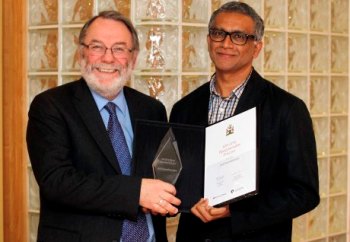Mar 2 2013
Anil Ananthaswamy has won the inaugural Physics Journalism Prize – a prize designed to inspire the next generation of physicists by encouraging journalists to grapple with often complex topics and help spread excitement about the subject.
 Anil has won the prize for his article Hip Hip Array, which focuses on the Square Kilometre Array, an international project to design and build the largest radio telescope ever conceived.
Anil has won the prize for his article Hip Hip Array, which focuses on the Square Kilometre Array, an international project to design and build the largest radio telescope ever conceived.
The prize is sponsored by the Institute of Physics (IOP) and the Science and Technology Facilities Council (STFC).
Anil, a consultant at New Scientist magazine and author of The Edge of Physics, will be congratulated today, Thursday 28 February 2013, at an IOP reception this evening in central London, which follows this year’s Newton Lecture by the Astronomer Royal, Lord Rees of Ludlow, entitled From Mars to the Multiverse.
Professor Sir Peter Knight, President of IOP, said, “Anil Ananthaswamy is being awarded the prize for writing a feature which brings one of the world’s most exciting astronomical endeavours to life – the Square Kilometre Array.
“I’m delighted that we’re able to honour his writing on this occasion, shortly after we hear from one of the UK’s leading astronomical luminaries.”
The Physics Journalism Prize offers an expenses paid trip to Japan, to visit world-leading facilities carrying out research at the frontiers of physics.
On winning, Anil commented, "Writing about physics, especially about the work being done in remote, difficult and sometimes hostile environments, is a special pleasure. Winning an award for doing what I love to do is just icing on the cake. I truly appreciate the recognition."
With Anil the overall winner, judges were impressed by the range of entries.
Zeeya Merali, a freelance science journalist based in Canterbury, has been given a special mention and a £250 prize for her Discover article, Gravity Off the Grid; an article about Julian Barbour, a British physicist who has spent his life arguing against Einstein’s view of gravity, space and time.
The judges – who were the Association of British Science Writers’ (ABSW) Martin Ince, the Wellcome Trust’s Mark Henderson, STEMNET’s Kirsten Bodley and the Science Media Centre’s Ed Sykes - commended both of the journalists for style, their ability to inspire and for bringing the physics that they write about to life.
ABSW director Martin Ince said, “The judges awarded the first prize and the commendation to two very different, but equally compelling, pieces of writing about physics. Both will have inspired and intrigued readers in the UK and around the world. The entries we received show that British science journalists can take on some of the most complex subjects in the universe and bring them to a wide audience.”
Mark Henderson, head of communications at the Wellcome Trust and former science editor at The Times, said, "This was a strong field, but the winning and commended entries stood out both for style and substance. Zeeya Merali crafts great metaphors that help to make complicated science comprehensible for non-specialist audiences, while Anil Ananthaswamy has an eye for illustrative detail of which the best travel writers would be proud.”
Kirsten Bodley, chief executive of STEMNET, said, “The winning article on the competition for the Square Kilometre Array will be particularly inspirational to young people, offering them an opportunity to see how fascinating contemporary physics research can be. This is close to STEMNET’s heart – it’s important to make science accessible and interesting for young people, to inspire the next generation of great British scientists and engineers.”
Commenting on the winner’s choice of topic, Terry O’Connor, head of communications at STFC, added, “The Square Kilometre Array will be one of the world’s largest and most complex science experiments, requiring physics input across the disciplines and at every stage of its design, construction and operation. It will open new avenues of research, and delve further back into the formation of the universe.
“With the SKA project office located in the UK at Jodrell Bank, and UK researchers and government heavily involved at every stage, we’re delighted that the winning article highlighted this fascinating and ambitious project.”
Anil’s article can be read on newscientist.com, free of charge (after a short registration).